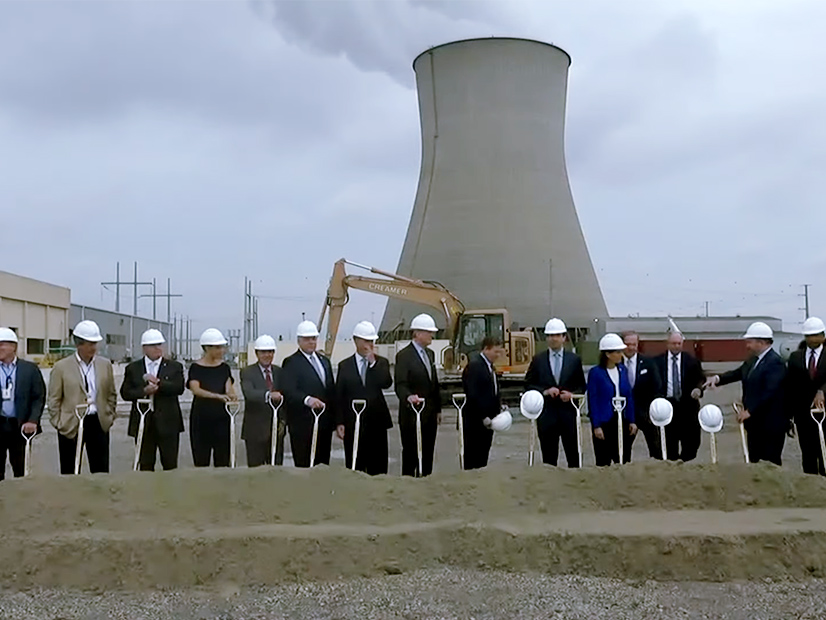
New Jersey officials broke ground on the New Jersey Wind Port project Thursday, predicting the manufacturing, assembly and marshalling hub in South Jersey would serve not only the state’s offshore wind projects but also others on the East Coast.
Gov. Phil Murphy (D) marked the start of construction on the port at the project site on the Delaware River in Lower Alloways Creek with a press conference that included U.S. Labor Secretary Martin Walsh, state and local elected officials, and union leaders. At the end of the conference, the United Building Trades Council of Southern New Jersey AFL-CIO signed a project labor agreement with AECOM-Tishman, the project construction manager, stating that union labor would be used for the project.
The wind port, and the effort to create a hub that will serve the regional wind industry supply chain, are key parts of Murphy’s goal to create a state offshore wind sector that will generate 23% of the state’s energy by 2050. The state aims to create wind projects totaling 7,500 MW by 2035.
The New Jersey Board of Public Utilities (BPU) has so far awarded three wind projects in two solicitations since 2019: the 1,100-MW Ocean Wind 1 and 1,148-MW Ocean Wind 2, both developed by Ørsted, and 1,510-MW Atlantic Shores, a joint venture between EDF Renewables North America and Shell New Energies US. The BPU is planning to hold three more solicitations over the next five years. (See: NJ Awards Two Offshore Wind Projects.)
“This location will provide essential staging, assembly and manufacturing activities related to offshore wind projects not just in New Jersey, but up and down the East Coast,” Murphy said. “For far too long, we’ve been fed a line that we could either create jobs or improve our environment and fight climate change, but not both. Today, I think we can finally put that old way of thinking to bed for good.”
He and other speakers said the state had seen proof of the need to act rapidly against climate change in the damage wreaked by Hurricane Ida last week, which dumped eight inches of rainfall in a single day, causing massive flooding that killed more than two dozen people.
Jobs and Investment
State officials say the New Jersey Wind Port will create up to 1,500 manufacturing, assembly, and operations jobs, as well as hundreds of union construction jobs. The port is expected to include a nacelle assembly facility built by General Electric (NYSE:GE) and another to be built with manufacturer MHI Vistas. German manufacturer EEW Group is building a monopile factory in the nearby Port of Paulsboro. (See New Jersey Shoots for Key East Coast Wind Role.)
The state picked the wind port site in June 2020 after a 22-month assessment process. The current state budget includes $200 million for the project, and the BPU has awarded it $13 million. The state budget, in partnership with the New Jersey Department of Transportation, will provide another $44 million for dredging. (See: NJ EDA Approves Lease and Funding for Offshore Wind Hub.)
The port’s website says the facility will “support up to $500 million in new economic activity within the state and region each year.” The port’s assets will include “purpose built marshalling space,” heavy-lift wharfs and open access to the Atlantic Ocean that is unimpeded by bridges, a key issue because wind turbines that can be hundreds of feet tall are transported upright to their destination. The port offers “short steaming distances” to more than 50% of U.S. offshore wind lease areas, the website says.
Murphy told the conference that the wind port would “establish New Jersey as both the epicenter of the nation’s offshore wind industry and the head of the offshore wind supply chain.”
State Senate President Stephen M. Sweeney, in whose district the port will be built and who fought to make it happen, said the state’s initiative will give New Jersey the edge in what could be a tough battle among states to grab a slice of the fast-growing wind industry.
“If you read around the country up and down the coast, every state’s racing for manufacturing,” he said. “But guess what? We’re here first. We got here first.”
East Coast Wind Competitors
Other states also are staking claims to the OSW supply chain.
The Port of Virginia announced a week ago that it has agreed to lease 72 acres of its Portsmouth Marine Terminal to Dominion Energy (NYSE: D) to serve as a staging and preassembly area for the 2.6-GW Coastal Virginia Offshore Wind project. And US Wind Inc. has outlined plans to develop 90 acres of waterfront in Baltimore County into an “offshore wind deployment hub,” including a factory for monopiles.
New York, with wind projects totaling 4.4 GW already procured, is developing wind support facilities at five locations, including a tower-manufacturing plant in the Port of Albany and a turbine-staging facility and operations and maintenance hub at South Brooklyn Marine Terminal.
Walsh called the New Jersey port project “transformative” and echoed the sense offered by state officials that the state’s project carried importance beyond the state boundaries. Walsh said it reflected President Biden’s effort to harness infrastructure development to boost economy opportunity and “create a pathway into the middle class,” creating opportunities for minority and women workers and business owners.
The New Jersey Economic Development Authority is working with AECOM-Tishman to ensure at least 25% of subcontractors for the port construction are small businesses and at least 15% are women-, minority- or veteran- owned, according to Murphy’s press release.
“This project is the beginning of an opportunity for us to really show a way forward,” Walsh said. “New Jersey is showing a way forward by this project right here, showing us how to do it in the country. Other states can follow suit.”


